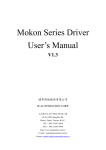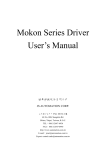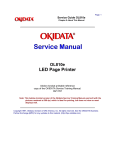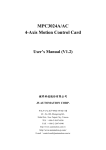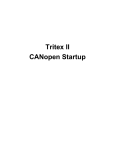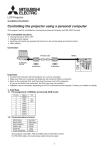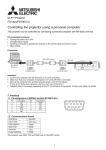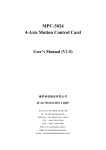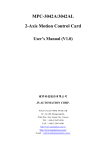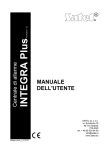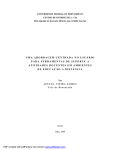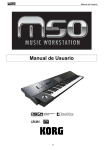Download Mokon Series Driver User`s Manual V2.0
Transcript
Mokon Series Driver User’s Manual V2.0 健昇科技股份有限公司 JS AUTOMATION CORP. 台北縣汐止市中興路 100 號 6 樓 6F,No.100,Chungshin Rd. Shitsu, Taipei, Taiwan, R.O.C. TEL:886-2-2647-6936 FAX:886-2-2647-6940 http://www.automation.com.tw E-mail:[email protected] Correction record Version Record 1.1 Add CN1-9 TLM+ Torque limit command 1.2 1 Adjust 2 Add 5. I/O Signal Definitions and CN1 Pin Assignments 20. Wiring of MPC3024 wiring board to Mokon driver 3 Modify description of CN1 Pin16 Hold 1.3 1. Chapter 5 I/O Signal Definitions and CN1 Pin Assignments Pin5,6,7,13,14,15,16,30,31,34 descriptions—rewrite for more detail Pin1,2 description—rewrite for more detail 1.4 1. Update Chapter 10,11,12 diagram 2. Update Chapter 20 Wiring of MPC3024 wiring board to Mokon driver 3. Update 15.1 Communication Protocol 2.0 YPV V2.0 1 Contents 1. Checking Mokon series products on delivery ................................................................................. 4 1.1 Servomotor nameplate descriptions....................................................................................... 4 1.2 Servomotor model.................................................................................................................. 5 1.3 Servo drive nameplate descriptions ....................................................................................... 5 1.4 Servo drive model.................................................................................................................. 6 1.5 Servo drive part names .......................................................................................................... 7 2. Servo drive installation precautions ................................................................................................ 8 2.1 Prevent foreign object intrusion............................................................................................. 8 3. Servo drive wiring precautions ..................................................................................................... 10 3.1 Main wiring.......................................................................................................................... 10 3.2 Wiring for the controller and the encoder............................................................................ 11 4. Servomotor installation precautions.............................................................................................. 12 4.1 Installation precautions ........................................................................................................ 12 4.2 Connect the servomotor with load precautions.................................................................... 12 4.3 Alignment ............................................................................................................................ 13 4.4 Handling oil and water......................................................................................................... 14 4.5 Cable stress .......................................................................................................................... 14 5. Encoder wiring and CN2 pin assignments of the servo drive ....................................................... 15 5.1 Signal waveform of feedback Encoder................................................................................ 15 6. Position command input circuit..................................................................................................... 17 6.1 From differential type line driver......................................................................................... 17 6.2 From open-collector output: ................................................................................................ 17 7. Analog command input circuit...................................................................................................... 18 7.1 Analog command input circuit ............................................................................................ 18 7.2 Digital input circuit interface............................................................................................... 18 8. Output interface circuits ................................................................................................................ 19 8.1 Digital output interface ........................................................................................................ 19 8.2 Encoder digital output interface circuit ............................................................................... 20 9. Position control interface .............................................................................................................. 21 10. Speed control interface.................................................................................................................. 22 11. Torque control interface ................................................................................................................ 23 12. Descriptions of Mokon servo drive input signals.......................................................................... 24 12.1 Input Signal definitions and CN1 pin assignments.............................................................. 24 12.2 Servo ON input (CN1-6)...................................................................................................... 27 12.3 RST Servo reset input (CN1-7) ........................................................................................... 27 12.4 TLM Torque limit input (CN1-13) ...................................................................................... 27 12.5 PRIH Forward rotation inhibited and NRIH reverse rotation inhibited inputs (CN1-14~15)28 12.6 Motor hold or PI/P control mode switch input (CN1-16).................................................... 28 12.7 MDO Operation mode ......................................................................................................... 29 2 13. 14. 15. 16. 17. 18. 19. 20. 21. 12.8 VCMD+ and TCMD+ inputs (CN1-1 and CN1-8).............................................................. 29 12.9 TLCMD+ Torque limit analog command input (CN1-9) .................................................... 30 12.10 +PPCMD –PPCMD, +NPCMD -NPCMD Position command inputs (CN1-26~29).. 30 12.11 SPD1 SPD2 SPD3 Internal speed switching inputs (CN1-32~35).............................. 31 Descriptions of Mokon servo drive Output signals....................................................................... 32 13.1 Output Signal definitions and CN1 pin assignments ........................................................... 32 13.2 ALM Servo alarm output (CN1-10) .................................................................................... 33 13.3 Brake motor brake release output (CN1-17)........................................................................ 33 13.4 Zero servo speed zero output (CN1-36) .............................................................................. 34 13.5 ITLM In torque limit output (CN1-37)................................................................................ 34 13.6 INS INP Speed/Position arrival output (CN1-18) ............................................................... 34 13.7 MON1 MON2 Analog monitor outputs (CN1-11~12) ........................................................ 35 13.8 Encoder output signals (CN1-19~24) .................................................................................. 35 User parameter settings and functions .......................................................................................... 36 14.1 Parameter settings and functions ......................................................................................... 36 Driver setup via PC communication ............................................................................................. 42 15.1 Setup communication protocol ............................................................................................ 42 15.2 Communication port to link with the servo driver............................................................... 43 15.3 Basic functions..................................................................................................................... 43 15.4 Common parameter.............................................................................................................. 44 15.5 Speed mode menu................................................................................................................ 50 15.6 Position mode menu............................................................................................................. 53 15.7 Torque mode ........................................................................................................................ 56 15.8 Motor Parameter Settings .................................................................................................... 58 15.9 Advanced Parameters .......................................................................................................... 59 15.10 Speed Loop Gain 1 ...................................................................................................... 59 15.11 Speed Loop Gain 2 ...................................................................................................... 60 15.12 Online Monitor ............................................................................................................ 62 Alarm display table ....................................................................................................................... 63 Connector pin assignments diagram ............................................................................................. 64 Servo drive dimension................................................................................................................... 65 Regenerate brake resistor selection guide ..................................................................................... 67 Wiring of MPC3024 wiring board to Mokon driver ..................................................................... 68 Appendix ....................................................................................................................................... 68 3 1. Checking Mokon series products on delivery Follow the procedure below to check Mokon Series products upon delivery Check the following items when Mokon Series products are delivered: 1. 2. 3. 4. Check the packed products for damages that may have occurred during shipping. Check whether the name and number of the delivered products are the same as those on the delivery sheet. Check whether the servomotor and servo drive capacity and encoder specification are the same as the ordered. In the case of special order, please carefully check the delivered products and contact our company immediately if any item is incorrect. The table below shows the standard set: 1. One servomotor 2. One servo drive 3. One 37PIN D type connector for CN1* 4. One 15PIN D type connector for CN2* 5. One connector for servomotor power line* 6. One encoder connector* 7. One copy of wiring description * If cable is your option, they will be soldered ready with the cable. 1.1 Servomotor nameplate descriptions Servo drive Model Rated Output Encoder Specification Motor Rated Speed Serial Number 4 1.2 Servomotor model YBL13S75 - L Z Servomotor Serial Number Design Revisions: K Shaft length 20mm S Shaft length 15mm B With brake Q Special shaft U Terminal box type V Oblique shaft X Cable Connector type Y Military standard connector Z Power cable connector M Water-proof L model N Water-proof V model Servomotor Pole Number and Encoder Resolution C 8P1024 P/R D 8P2048 P/R E 4P2500 P/R F 4P5000 P/R H 4P2048 P/R I 8P5000 P/R J 4P1024 P/R L 8P2500 P/R 1.3 Servo drive nameplate descriptions Servo drive Model Serial Number Version Servo drive Specification 5 1.4 Servo drive model YPV - 300-V YPV Series Servo drive Servodrive Capacity 040 0.4 KW 600 055 0.55 KW 750 075 0.75 KW 860 100 1 KW 1100 150 1.5 KW 1500 200 2 KW 2200 300 3 KW 3000 450 4.5 KW 6 KW 7.5 KW 8.6 KW 11 KW 15 KW 22 KW 30 KW Type V High resolution speed / Torque command: 12-bit resolution 6 1.5 Servo drive part names The figure below shows the part names of the servo drive. CN3 Communication Connector Used to communicate with a personal computer (RS-232) or a control panel Charge Indicator Lights when the main circuit power supply is ON and stays as long as the main circuit power supply capacitor remains charged. Therefore, do not touch the Servo drive even after the power supply is turned off if the indicator is lit. CN1 I/O Signal Connector Used to input command or sequence I/O signals. Main Power Supply and Servomotor Terminals (RST) used for AC mains input(3 , 220Vac) (E) Ground Terminal, must be connected to prevent electrical shock (UVW) Servomotor Cable Terminal (B1 B2) Brake Resistance Terminal (H1 H2) Servomotor Thermostat Terminal CN2 Encoder Connector Connects to the encoder in the servomotor. 7 2. Servo drive installation precautions The servo drive should be stored in the environment with ambient temperature range of 0-55 C (no freezing) and relative humidity under 90% RH (no condensation). Installation Orientation and Spacing: 1. When installing the servo drive, make the front panel containing connectors face outward and take into consideration the easy connection/disconnection of CN1 and CN2 connectors for measurement. 2. For multiple servo drive installation in the control cabinet, allow at least 40mm between each. When installing servo drives side by side as shown in the figure below, allow at least 50mm above and below each servo drive or install cooling fans to facilitate air circulation. Servo drive Installation and Cooling Method 2.1 Prevent foreign object intrusion 1. Prevent the drilling and cutting chips from entering the servo drive during installation. 2. Avoid the odd objects like oil water and metal powder from entering the servo drive via cooling fans. 3. If using fans for cooling, please install the filter properly at the ventilating hole, and consider the surrounding environment to choose the best direction for ventilation. 4. Please install heat exchanger or air filtering system when installing in locations subject to poisonous gas or excessive dust. 8 Extra Notices: 1. Do not install the servo drive in locations likely to be affected by oil and dust. If unavoidable, please install the Servo drive in the airtight control cabinet and consider using ventilation filter. Also use a protective cover over the Servomotor. 2. When installing multiple servo drives in one airtight control cabinet, allow at least 50mm between, above and below each servo drive and leave 120mm for maintenance space. In addition, to ensure the reliability and improve the product life, leave certain distance between the servo drive and the cabinet ceiling so the temperature around the servo drive does not exceed 55 C which might lead to poor ventilation. 3. A frequent use of the regenerative resistor may lead to a temperature higher than 100 C. Do not put inflammables or heating deformable objects around. The wirings must also be kept away from the resistor or severe damage will occur. 4. When installing near a source of vibration, install a vibration isolator to protect the Servo drive from vibration. 9 3. Servo drive wiring precautions Wiring precautions 3.1 Main wiring 1. Apply three-phase 220V AC mains through the NFB to the magnetic contactor, then connect to the servo drive RST terminals. Consider installing a reactor and linear noise filter if the local power supply quality is poor. 2. Connect the UVW terminals of the servo drive with the red, white and black cable lines of the servomotor directly or via terminal board, on which the cable lines be secured with a terminal plier and wrapped tightly to avoid incidental short-circuit, power interruption or earth faults. 3. Make sure the cable lines are not damaged under stress. Be cautious of the cable wiring to avoid as much as possible being subject to bending or tension. 4. If the servomotor is moving with the mechanism, arrange the bending section of the cable line within the allowable curvature which is determined from the cable specification to assure normal operation life. 5. Make sure the cable lines are not touched by sharp parts of the machine or pressed by any heavy object. 6. Provide proper grounding wiring for the ground terminals of the servo drive and servomotor. 7. H1 and H2 are the thermostat terminals for the servomotor. Strictly forbid to short circuit them with the machine bed or falsely connect with U V W E terminals. 8. After fastening the main terminal board, the ends of the wiring terminals can be bended up to be kept away from the front nameplate as shown be 10 3.2 Wiring for the controller and the encoder 1. Each pin of CN1 and CN2 must be soldered and checked carefully for correct pin number Check the adjacent pins after soldering to avoid being incidentally shorted circuit by the solder or unused leads. 2. Wrap the soldered leads with shrinkable tubes to keep from being touched by each other. 3. If the leads from CN2 must be extended, care must be taken in the connection section and proper shielding measures must be adopted to suppress EMI noise. 4. Do not stretch tight the leads of CN2 to avoid wiring faults of the encoder. 5. Power cables and signal lines should not be arranged in close parallel, and the leads for control signals should be twisted and shielded. Note: Be cautious of the length of the wiring and the measures for noise shielding if Mokon series is used in position control mode. If not using the line driver type, the PULSE GND must be connected to DGND, or the lost pulse fault may occur. CAUTION 1. Do not bundle power and signal lines together in the same duct. Leave at least 30cm (11.81 in.) between power and signal lines. 2. Use twisted-pair wires or multi-core shielded-pair wires for signal and encoder (PG) feedback lines. 3. The maximum length for signal input lines is 3m (118.11 in.) and for PG feedback lines is 20m (787.40 in.). 4. Do not touch the power terminals for 5 minutes after turning power off because high voltage may still remain in the servo drive. 5. Make sure the Charge Indicator is out before starting an inspection. 6. Avoid frequently turning power on and off. Do not turn power on or off more than once per minute. 7. Since the servo drive has capacitors in the power supply, a high charging current flows for 0.2 seconds when power is turned on. Frequently turning power on and off will cause main power devices like capacitors and fuses to deteriorate, resulting in unexpected problems. 11 4. Servomotor installation precautions 4.1 Installation precautions Try to avoid water and oil exposure since the servomotor contains no water-proof structure. Install a water-proof cover if it is used in a location that is subject to water or oil. 1. Servomotor cable line facing downward can prevent the oil and water from entering the servomotor via cable line. 2. If the servomotor is installed vertically or with a slope, the cable line should be bended to U-type to avoid the oil and water from entering via the cable line. 3. Carefully avoid the exposure of cable lines to oil and water that have adverse effects on servomotor and encoder, also may cause malfunctions of the servo drive. 4.2 Connect the servomotor with load precautions 1. To mount a belt wheel, use the set screw to secure it on the shaft end if the motor shaft has a keyway; Use a friction coupling if the motor shaft has no key way. 2. Use a special tool to dismantle the belt wheel, avoiding impact to the shaft. 3. Strictly forbid to exert force on the back cover of the encoder by hands or ropes when moving the servomotor. 4. Strictly forbid the use of hammer to strike the shaft (likely to damage the encoder) 12 Avoid violent collision and vibration of servomotor when mounting a belt wheel or a clutch! The encoder connecting with the shaft is vulnerable under intense vibration which may adversely affect the resolution and service life of the servomotor. 5. Do not change the encoder wiring direction. 6. Use a flexible connector. The round-off must meet with the allowable radial load. 7. Choose a proper pulley, chain wheel or timing belt that can meet with the requirement of the allowable radial load. 8. If the servomotor is attached with a magnetic brake, either horizontal or vertical installation is allowed. When the shaft is upward installed, the brake may normally make some noise. 4.3 Alignment Align the shaft of the servomotor with the shaft of the apparatus, and then couple the shafts. Install the servomotor so that alignment accuracy falls within the following range. . Measure this distance at four different positions around. The difference between the maximum and minimum measurements must be below 0.03mm (0.0012 in). (Turn together with the coupling.) . Measure this distance at four different positions around. The difference between the maximum and minimum measurements must be below 0.03mm (0.0012 in). (Turn together with the coupling.) 13 4.4 Handling oil and water Install a protective cover over the servomotor if it is used in a location subject to water or oil mist. Also use a servomotor with an oil seal to seal the through shaft section. 4.5 Cable stress Make sure there are no bends or tension on the power lines. Be especially careful to signal line wiring to avoid stress because the diameter of the core wires is only 0.2 to 0.3mm (0.0079 to 0.012 in). 14 5. Encoder wiring and CN2 pin assignments of the servo drive Motor RSO Connector Motor Side Cable Color Name of the Signal Servo drive Side Pin No. 1 Green A 1 2 White Grey /A 2 3 Gray B 3 4 White Gray /B 4 5 Yellow C 5 6 White Yellow /C 6 7 Brown U 7 8 White Brown /U 8 9 Orange W 9 10 White Orange /W 10 11 Blue V 11 12 White Blue /V 12 13 Red +5V 13 14 White Red GND 15 Silver braided wire Shielding 14 15 Case 5.1 Signal waveform of feedback Encoder The figure below shows the forward rotation (CCW) waveform of the encoder 15 16 6. Position command input circuit 6.1 From differential type line driver 6.2 From open-collector output: Example 1: Using an external power supply provided by the user Note: Mokon Servo drive can be only connected with 24V external power supply. Example 2: Using power supply built in the servo drive 17 7. Analog command input circuit 7.1 Analog command input circuit 7.2 Digital input circuit interface 18 8. Output interface circuits 8.1 Digital output interface Example 1: Connecting to a relay output circuit Example 2: Connecting to a photo coupler output circuit 19 8.2 Encoder digital output interface circuit 20 9. Position control interface 21 10. Speed control interface 22 11. Torque control interface 23 12. Descriptions of Mokon servo drive input signals 12.1 Input Signal definitions and CN1 pin assignments Signal Type Pin Name Pin No. Common +15V 3 Function Descriptions +15V voltage output ±15V volt with allowable 50mA output , spare for external analog use. -15V 4 -15V voltage output 24G 5 Common power ground for user control interface. SON 6 Servo on Digital signal for activating the servo drive when connected with 24G.(internal 24V pull high) RST 7 Alarm reset Digital signal for releasing the servo drive when connected with 24G.(internal 24V pull high) TLM 13 Torque Limit Digital signal for torque limit when connected 24G(internal 24V pull high) PRIH 14 Forward Rotation Digital signal for inhibiting the forward rotation when Inhibited connected with 24G.(internal 24V pull high) NRIH 15 Reverse Rotation Digital signal for inhibiting the reverse rotation when Inhibited connected with 24G.(internal 24V pull high) HOLD 16 Motor HOLD (forward and reverse rotation inhibited) Speed Loop Control OR PI/P +5V 30 DGND 31 MDO 34 Digital signal for inhibiting the forward and reverse rotations when connected with 24G, in position mode, the input pulse counter will be cleared; or switching between PI / P control modes under the speed operation mode . (The function of this pin is selected in the "common Parameter" menu .)(internal 24V pull high) 5V voltage output 5 volt with allowable 50mA output, spare for external use. 5V ground output 5V power ground, also ground for ±15V. Operation Mode connected with 24G will switch the operation mode. switch (defined by Common parameter->Control mode selection) S / P Speed mode < - > Position mode P / T Position mode < - > Torque mode S / T Speed mode < - > Torque mode (internal 24V pull high) 24 Signal Type Pin Name Pin No. SPEED VCMD+ 1, 8 Function Descriptions Speed command During driver set at speed mode: Enable the motor to run at speed proportional to the speed command voltage . At ±10V input , the motor runs ±3000rpm , or ±2000rpm . Positive voltage corresponds to forward rotation , while negative voltage corresponds to reverse rotation . (pin8 can also act as low resolution speed command input) TORQUE AGND 2 Analog ground Analog signal ground TCMD+ 1 Torque command During driver set at torque mode: Enables the motor to output torque proportional to the torque command voltage . At ±10V , the motor output 300% rated torque . TLM+ 9 Torque limit command Enabled while TLM (pin13) active low, At ±10V , the motor output is limited at 300% rated torque . The function is also available in speed mode. AGND 2 Analog ground Analog signal ground 25 Signal Type Pin Name Pin No. Position EPI 25 Function Descriptions External Power input +24V External Power input for open collector pulse driver. Command (If TTL or line driver pulse source, the EPI power input is no need) Ref 7. Position Command Input Circuit +PPCMD 26 Forward rotation Forward rotation pulse Input+ pulse Input+ (CW+ / Pulse+ /A+) -PPCMD 27 Forward rotation Forward rotation pulse Inputpulse Input(CW- /Pulse- /A-) +NPCMD 28 Reverse rotation Reverse rotation pulse Input+ pulse Input+ (CCW+ / Dir+ /B+) -NPCMD 29 Reverse rotation Reverse rotation pulse Inputpulse Input(CCW- / Dir- /B-) Common EG1/SPD Signal for Position and Speed EG2/SPD2 Command 32 Electronic gear 1 Input signal as electronic gear selection 1 in Speed selection 1 position operation mode or as speed selection 1 in speed operation mode . 33 Electronic gear 2 Input signal as electronic gear selection 2 in Speed selection 2 position operation mode or as speed selection 2 in speed operation mode . EG3/SPD3 35 Electronic gear 3 Input signal as electronic gear selection 3 in Speed selection 3 position operation mode or as speed selection 3 in speed operation mode . 26 12.2 Servo ON input (CN1-6) This signal is used to turn on and off the power to the servomotor. Note: 1. Contact this input to ground will make the Mokon driver ready to receive the command pulse or analog voltage input. 2. Open the contact will make the servo motor free run. Do not use this signal to work as motor stop signal. 12.3 RST Servo reset input (CN1-7) This signal is used to reset the servo drive after clearing the servo alarm. 12.4 TLM Torque limit input (CN1-13) This signal, together with the TLCMD+ analog voltage input (CN1-9) torque limit signal, is to protect the apparatus or work piece. If the input torque limit exceeds the maximum motor rated torque, then the maximum motor rated torque is the maximum torque limit. A too low torque limit might cause the problem of insufficient torque during acceleration/ deceleration. 27 12.5 PRIH Forward rotation inhibited and NRIH reverse rotation inhibited inputs (CN1-14~15) These two signals force the moving part of the apparatus to stop if they travel over the allowable range of motion. Connect the overtravel limit-switch signals to the correct pins (PRIH for forward overtravel, NRIH for reverse overtravel) of the servo drive CN1 connector. (as shown below) 12.6 Motor hold or PI/P control mode switch input (CN1-16) If Motor Hold function is selected, the servomotor will be stopped and held still when CN1-16 is connected with 24G. The servomotor is decelerated according to the programmed profile. If PI/P Control Mode Switch function is selected, the speed loop will be changed from PI mode to P mode when CN1-16 is connected with 24G and. The mode switching function is described below: Applications: 1. To suppress the overshoot during acceleration/deceleration under the speed operation mode. 2. To suppress the undershoot or decrease the settling time under the position operation mode. 28 12.7 MDO Operation mode If the CNTL parameter is set in the “Common Parameter" menu as S/P (speed/Position), P/T (Position/Torque), or S/T (Speed/Torque) mode, this input signal enables the switching between operation modes. For example: If CNTL is set as S/P mode, when CN-34 and 24G is not connected, the servo drive is in Speed operation mode, when connected; the servo drive is switched to Position operation mode. 12.8 VCMD+ and TCMD+ inputs (CN1-1 and CN1-8) VCMD+: When the servo drive is in S Mode or is switched to S mode, this signal is used as analog speed command input. The input voltage scale can be modified at the VMDL parameter contained in the “Speed Parameter" menu. The value of the VMDL parameter defines the input voltage which corresponds to the rated speed, with positive voltage for forward rotation, and negative voltage for reverse rotation. TCMD+: When the servo drive is in T Mode or is switched to Torque operation mode, this signal is used as analog torque command input. If the input voltage is 10V, the motor outputs 300% of the rated torque. Note: CN1-1 is for high-resolution analog signal input (12 BIT). Please purchase YPV-XXX-V series servo drive if high-resolution analog input is needed. The input pin of the standard analog input (resolution 10 BIT) is CN1-8. 29 12.9 TLCMD+ Torque limit analog command input (CN1-9) This signal is used as analog torque limit command input when CN1-13 is connected with 24G. If the input voltage is 10V, the limit range corresponds to 300% of the rated torque of the motor. 12.10 +PPCMD –PPCMD, +NPCMD -NPCMD Position command inputs (CN1-26~29) When the servo drive is in P Mode or switched to Position operation mode, these signals are used as position command inputs. The type of the command can be changed within the parameter. The position command signals can be any of the following forms (refer to 6. Position command input circuit): 1. Differential type 2. +24V open-collector type 3. +5V open-collector type 30 12.11 SPD1 SPD2 SPD3 Internal speed switching inputs (CN1-32~35) ELGN1 ELGN2 ELGN3 Electronic Gear Numerator Switching Inputs (CN1-32~35) When the servo drive is in S Mode or switched to Speed operation mode, and if the internal speed is enabled, the internal speed command can be selected by properly connecting one among CN1-32 (SPD1), CN1-33(SPD2) and CN1-35(SPD3) to 24G. The three pins correspond to three different internal speed commands which are defined by the parameters Internal Speed 1, Internal Speed 2 and Internal Speed 3 (Unit: RPM) in the “Speed Parameter"menu. When the servo drive is in P Mode or switched to Position operation mode, the numerator of the electronic gear ratio can be selected by properly connecting one among CN1-32 (ELGN1), CN1-33 (ELGN2) and CN1-35 (ELGN3) to 24G. The three pins correspond to three different numerators that are defined by the parameters Numerator 1, Numerator 2 and Numerator 3 in the “Position Parameter" menu, where a common denominator of the electronic gear ratio is also programmed . 31 13. Descriptions of Mokon servo drive Output signals 13.1 Output Signal definitions and CN1 pin assignments Signal Type Common Pin Name Pin No. Function Descriptions ALM 10 Servo Alarm Digital signal for alarm BRAKE 17 Motor Brake Release Signal Digital signal for releasing the motor brake Speed ZERO 36 Motor Low Speed Output Digital signal output indicating the servomotor is running at speed lower than the user setting . In Torque Limit ITLM 37 Output In Torque Limit is saturated at the torque limit value in torque is saturated at the torque limit value in torque operation mode . Speed/Position Common Signal INP/INS 18 Position/Speed Arrival Digital signal output for indicating the value of position error counter is smaller than the user setting in position operation mode , or the motor speed is smaller than the user setting in speed operation mode . Analog Output MO1 11 Analog output 1 Analog output MO2 12 Analog output 2 Analog output A 19 Encoder A phase /A 20 Differential , line driver digital output signal A phase . B 21 Encoder B phase /B 22 Differential , line driver digital output signal B phase . Z 23 Encoder Z phase /Z 24 Differential , line driver digital output signal Z phase . Encoder Signal Output 32 13.2 ALM Servo alarm output (CN1-10) This signal indicates that an abnormal state of the servo drive occurs. 13.3 Brake motor brake release output (CN1-17) If CN-17 is programmed as the brake release signal, when the driver is enabled through the contact of SON (CN 1-6) and 24G, the brake release signal will be issued after a delay time defined by the MBR parameter in the “Common Parameter"menu. If CN-17 is programmed as the servo ready signal (default), after the driver is enabled and no alarm has been detected, the servo ready signal will be issued immediately. When the system power is turned off, the servomotor with brake prevents the movable parts from dropping due to gravity. The brake built in the servomotor is of passive type and is intended only for holding the motor and cannot be used to actually stop a rotating motor. Be sure that the holding brake is applied after the motor is stopped. The braking torque is at least 120% of the rated motor torque. 33 13.4 Zero servo speed zero output (CN1-36) This signal is used to indicate that the speed of the servomotor is lower than or equal to the ZSPD parameter set in the “Speed Parameter" menu and issued by connecting CN1-36 to 24G. 13.5 ITLM In torque limit output (CN1-37) When the servo drive CN1-13 (TLM) is connected with 24G or if the output torque is saturated at the limit set by the driver, CN1-37 will be connected with 24G to issue the In Torque Limit signal. 13.6 INS INP Speed/Position arrival output (CN1-18) If the servo drive is set as S Mode, when the motor speed is equal to or higher than the INS parameter set in the “Speed Parameter" menu, CN1-18 will be connected with 24G to issue the Speed Arrival signal. If the Servo drive is set as P Mode, when the value of the position error counter is equal to or lower than the INP parameter set in the “Position Parameter"menu, CN1-18 will be connected with 24G to issue the Position Arrival signal. 34 13.7 MON1 MON2 Analog monitor outputs (CN1-11~12) These output signals are for monitoring the dynamic states of the servo drive and can be selected in the “Common Parameter" menu, in which the scale, offset and resolution of the output signals are also defined MON1: as Monitor Channel A defined the “Common Parameter" menu; MON2: as Monitor Channel B defined the “Common Parameter" menu 13.8 Encoder output signals (CN1-19~24) Encoder output signals, derived from the servo drive, can output to an external Host Controller. The Host Controller then uses these signals in its control circuit. 35 14. User parameter settings and functions 14.1 Parameter settings and functions YPV driver parameter definitions parameter no. register 0 EEPW 0:write parameters into EEPROM 1 CNTL Servo control mode 0 = Torque mode 1 = Speed mode 2 = Position mode 3 = Speed/Position mode 4 = Position/Torque mode 5 = Speed/ Torque mode 2 PMOD function/data mode initial unit range 0 0 S、P、 3 0~5 P 0 0~2 T PULSE CMD TYPE 0=PULSE/DIR 1=A/B 2=CW/CCW Note: no valid for YPV ver 2 3 Ta acceleration time for speed mode linear acceleration profile. Note: internal generated profile, if use external profile generator set this parameter to 0 S 0 ms 0~ 10000 4 Td deceleration time for speed mode linear acceleration profile. Note: internal generated profile, if use external profile generator set this parameter to 0 S 0 ms 0~ 10000 5 Tsa acceleration time for speed mode S acceleration profile. Note: internal generated S 0 ms 0~ 10000 36 remark profile, if use external profile generator set this parameter to 0 6 Tds deceleration time for speed mode S acceleration profile. Note: internal generated profile, if use external profile generator set this parameter to 0 S 0 ms 0~ 10000 7 PACC Pulse mode control acceleration time. Note: internal generated profile, if use external profile generator set this parameter to 0 P 0 ms 0~ 10000 8 SP0 0: internal speed generator disable 1: internal speed generator enable S 0 9 SPD1 speed1 of internal speed generator Note: selected by SPD1 digital input, while SP0=1 S 500 RPM - rated RPM ~ + rated RPM 10 SPD2 speed2 of internal speed generator Note: selected by SPD2 digital input, while SP0=1 S 1000 RPM - rated RPM ~ + rated RPM 11 SPD3 speed3 of internal speed generator Note: selected by SPD3 digital input, while SP0=1 S 2000 RPM - rated RPM ~ + rated RPM 12 VMDL speed command voltage to motor rated speed S 10 V 0~10 S、T 0 0~1 Note: 10 means 10V for 2000 RPM rated speed motor. 13 SPDO Voltage input offset for 37 ± 1024 speed/torque mode 14 ZSPD zero speed range Note: when motor speed equivalent voltage less than the setting voltage the CN1-37 (ZERO) will make. S 50 RPM 0~ rated RPM 15 INS speed agreed range. Note: when motor speed equivalent voltage less than the setting voltage the CN1-18 (INS) will make. S 2000 RPM 0~ rated RPM 16 TQL torque limit in speed /position mode Note: function only valid while CN1-13(TLM) short to 24G S、P 300 % 0 ~300 17 TLCS torque limit source 0: internal 1: external analog command voltage (from CN1-9) S、P 1 18 TQCA filter time constant for torque command input Note: Larger time constant will decrease the band width of response T 15 19 DOLO output polarity 0: normal open 1: normal close S、P、 0 0~1 R/W 2000 0~ R/W 20 TSL 0~1 us R/W 15 ~ 10000 T speed limit for torque mode T rated RPM 21 KVP1 proportional gain1 for speed loop S 3000 0~ 30000 22 KVP2 proportional gain2 for speed loop S 3000 0~ 30000 23 KVI1 integral gain1 for speed loop S 130 0~ 30000 24 KVI2 integral gain2 for speed loop 130 0~ 30000 25 SPDB dead band of speed command 0 0~ 38 rated RPM 26 KPP1 27 proportional gain for position loop S 300 0~ 30000 Not available 28 SSPD speed loop gain switch level (speed lower than SSPD, switch from gain1 to gain2) 300 29 CNTR Refer appendix 1 30 DO17 function configuration of CN1-17 0: active while servo ready 1: brake release while P037 (MBR) time out S、P、 In-position range Note: position error falls into this range the CN1-18 (INP) will be active P 100 % 0~ 300 0~1 T 31 INP Pulse 32 ELGN numerator of gear ratio P 10 1~ 30000 33 ELGN1 numerator 1of gear ratio (selected by EG1 digital input) P 10 1~ 30000 34 ELGN2 numerator 2 of gear ratio (selected by EG2 digital input) P 100 1~ 30000 35 ELGN3 numerator 3 of gear ratio (selected by EG3 digital input) P 1000 1~ 30000 36 ELGD denominator of gear ratio P 10 1~ 30000 37 MBR brake release delay timer, after power on the CN1-17 BRAKE will active during MBR time out S、T、 500 ms 0~200 0 P 38 MONO1 offset of monitor output1 0 mv -127~1 27 39 MONO2 offset of monitor output2 0 mv -127~1 27 39 R/W 40 MONT1 source of monitor output1 0:servo motor current 1:speed 2:position error counter 1 0~2 41 MONT2 source of monitor output2 0:servo motor current 1:speed 2:position error counter 1 0~2 42 MONL speed monitor output voltage of rated speed ±10V =±2000 OR ±3000 RPM ±8V = ±2000 OR ±3000 RPM 10 V 0 ~ 10 43 MTYP Motor pole number 8 pole 2 ~ 48 44 RPM Motor rated RPM 2000 RPM 0~ 10000 45 ENCO Encoder pulses per motor revolution 2500 Pulse 1~ 10000 46 IPEK Driver peak current 47 DCDY Regenerate discharge duty cycle 48 POEN Numerator of encoder output ratio 1~ 32767 49 POED Denominator of encoder output ratio 1~ 32767 50 IMON Real time current value for monitoring ma RO 51 SMON Real time speed value for monitoring RPM RO 52 OSLV over-speed limit S 3000 RPM 0~ 10000 53 PERZ over error counter limit Note: 0: disable PERZ function P 3000 0 pulse 1~ 32766 S 1 54 not available 55 not available 56 ADO ma voltage command source 1 = high resolution (always choose) 40 50 % 0~ 100 0~1 Note: YPV ver2 is 14 bit resolution 57 not available 58 not available 59 60 MRO DI-16 61 62 65 T、S、 CN1-16 DI function selection 0 = CN1-16 works as HOLD function 1 = CN1-16 works as PI and P compensation switch 1 0~1 S、P 0 0~1 T 0 0~1 R/W S、P、 0 0~1 R/W P not available TSLO 63 64 motor rotation direction 0: positive command voltage in CCW direction 1: positive command voltage in CW direction speed limit source of torque mode 0: internal 1: external(analog voltage in) not available DILS SVER polarity of over-travel limit input CN1-14 and CN1-15 0: normal, ground input to PRIH , NRIH input will activate the function. 1: invert, open input to PRIH , NRIH input will activate the function. Software version T RO 41 15. Driver setup via PC communication 15.1 Setup communication protocol 1. Right click the mouse on my computer icon, Choose the “Properties” item 2. Select “Hardware” -> “Device manager” 3. Select “Ports (COM & LPT) and choose the com 4. Select “Port Settings” to change parameters port you are connecting to. Bits per second = 9600 Data bits = 8 Parity = None Stop bits = 1 Flow control = none 42 15.2 Communication port to link with the servo driver Start -> Program Files-> JS Automation->YPV The figure left shows the display of ComPort Setting, please choose the Communication Port used by your computer first. 15.3 Basic functions Mokon Servo drive has the following five menus for parameter setting: 1. Common Parameter 2. Speed Mode Parameter 3. Position Mode Parameter 4 Torque Mode Parameter 5. Motor Parameter 43 15.4 Common parameter Select control mode Mokon servo drive has six operation modes for selection T Mode: Torque mode, which is a single mode and cannot be switched through CN1-34 (MDO) S Mode: Speed mode, which is a single mode and cannot be switched through CN1-34 (MDO) P Mode: Position mode, which is a single mode and cannot be switched through CN1-34 (MDO) S/P Mode: Speed <-> Position mode, which can be switched through CN1-34 (MDO) P/T Mode: Position <-> Torque mode, which can be switched through CN1-34 (MDO) S/T Mode: Speed <-> Torque mode, which can be switched through CN1-34 (MDO) 44 Electromagnetic brake release time (MBR) MBR is effective only when CN1-17 is programmed as the Motor Brake Release function. Available range: 0~ 1000 ms Monitor voltage (MOVL) 45 This field is used to set the maximum output voltage of the monitoring signals for both channel A and channel B, default value is 10V. If S Monitoring is selected, the maximum output voltage corresponds to the motor rated speed. If I Monitoring is selected, the maximum output voltage corresponds to the motor 300% rated current. If P Monitoring is selected, the maximum output voltage corresponds to the tracking error setting set in the “Motor Parameter" menu. Motor definition rotation You can choose positive command voltage to CW rotation or CCW rotation. Select CN1-16 function 46 You can choose CN1-16 as 1. Hold function input, when the input active will hold the servo immediately and clear the error counter in position mode. 2. PI/P Speed Loop Control Mode Switch input, when the input active, the driver will enter a P speed control mode. Select CN1-17 function You can choose CN1-17 as Servo Ready output: CN1-17 will be closed immediately when the servo drive is turned on and turn off when an alarm has been detected to signal the controller. Electromagnetic brake control output: When SON (CN1-6) is engaged, CN1-17 will not be closed until after a delay time set by the Electromagnetic brake release time parameter; when SON (CN1-6) is disengaged, CN1-17 will not be open until after a delay time set by the Electromagnetic brake release time parameter. 47 Output logic selection Define the logic of CN1-10, CN1-17, CN1-18, CN1-36, CN1-37 output signals 1. Positive logic 0, the secondary side of the photocoupler is closed when the output signal is issued. 2. Negative logic 1, the secondary side of the photocoupler is open when the output signal is issued. Logic for positive and negative limit Logic for positive and negative limit: Define the input logic of CN1-14 (Forward/Positive Rotation Inhibited PRIH) and CN1-15 (Reverse/Negative Rotation Inhibited NRIH). 1. Positive logic, motor forward and reverse rotations are inhibited when CN1-14, CN1-15 are connected with 24G (CN1-5) respectively. 2. Negative logic, motor forward and reverse rotations are inhibited when CN1-14, CN1-15 are not connected with 24G (CN1-5) respectively. 48 Upload The input parameters will be transmitted and stored in the registers of the servo drive. (The parameters will not be maintained in the servo drive after the power is turned off.) input Upload and Program After entering the parameters, it is necessary to press this button to write these parameters stored in the registers onto the FLASH ROM in the servo drive. These parameters will thus be maintained in the servo drive and not disappear after the power is turned off. 49 15.5 Speed mode menu Voltage Command Input voltage (VMDL) Allowable range: ±2V ~ ±10V Used to scale the input voltage command (CN1-1 or CN1-8). Set the maximum input voltage of the speed command, and this maximum voltage corresponds to the rated speed of the servomotor. Offset voltage(SPDO) Allowable range: -1024 ~ +1024 mV Used to compensate for the offset of the voltage command. Set the offset voltage according to the actual condition, and the desired speed command is obtained internally by subtracting this setting from the input voltage (CN1-1 or CN1-8). Speed Command Channel (ADO) Select the speed analog command channel AD, analog command input from CN1-8, resolution 10 Bit VCO, analog command input from CN1-1, resolution 12 Bit (Mokon driver is suggest to use VCO) 50 Lowest speed (SPDB) The servo drive will work only when the speed command is higher than the minimum motor speed setting. If controlled by the numerical controller, set this value to 0. Minimum speed command can be set under the following situations: * The servomotor cannot be stopped at zero analog command. * The analog speed command is jammed by large noise and thus the servomotor cannot be stopped. Internal Speed Settings Internal Speed (SP0) Enable or disable the function of CN1-32 (the first internal speed), CN1-33 (the second internal speed) and CN1-35 (the third internal speed) in the speed operation mode. 1st Internal Speed Settings 2nd Internal Speed Settings 3rd Internal Speed Settings To set the pre-defined internal speed command. If the Internal Speed Enable Setting (SP0) is set as “Enable", the 1st internal speed (SPD1) will be executed if CN1-32 is connected with 24G. If the Internal Speed Enable Setting (SPO) is set as “Enable", the 2st internal speed (SPD2) will be executed if CN1-33 is connected with 24G. If the Internal Speed Enable Setting (SPO) is set as “Enable", the 3st internal speed (SPD3) will be executed if CN1-35 is connected with 24G. Acceleration/Deceleration Time 51 Linear acceleration time(Ta) Linear deceleration time(Td) Setting the linear deceleration/ deceleration time constant S curve acceleration time(Tsa) S curve deceleration time(Tsd) Setting the S curve deceleration/ deceleration time constant If controlled by a host numerical controller, set all the acceleration/deceleration time to 0. Before setting S-type acceleration/deceleration time, linear acceleration/deceleration time must be set; otherwise the characteristics of S-type acceleration/deceleration cannot be performed. Output Settings Zero Speed Under speed operation mode, when the motor speed is lower than or equal to the set value of ZSPD, CN1-36 will be conducted. In Speed Under speed operation mode, when the motor speed is higher than or equal to the set value of INS, CN1-18 will be conducted. 52 15.6 Position mode menu Position Command Command Type Mokon servo drive can accept the following three types of command Filter frequency Filter frequency is only valid if the “Command type” is selected as “A+B WITH FILTER” Pulse command trigger type To select the polarity of the command pulse, Hi to Low trigger or Low to Hi trigger. 53 In position range To set the range when the error count pulse is less than the value driver will take it as complete of positioning the CN1-18 will be engaged. Electronic Gear Denominator The common denominator of the 4 numerator. Numerator Available range: 0 ~ 32767 If the servo motor feedback encoder is 2500ppr (2500 x 4 pulse per revolution) and the Denominator is set to 5000, the Numerator set to 10000. The controller command pulse will be 5000 pulses to run the motor one revolution. Command pulses to = run one revolution 2500 (Encoder pulse per revolution) X 4 / 10000 (Numerator) 5000 (Denominator) Numerator1 Under the position operation Mode, Numerator 1 will be selected as the numerator of the electronic gear ratio when CN1-32 is connected with 24G. Numerator2 Under the position operation Mode, Numerator 2 will be selected as the numerator of the electronic gear ratio when CN1-33 is connected with 24G. Numerator3 Under the position operation Mode, Numerator 3 will be selected as the numerator of the electronic gear ratio when CN1-35 is connected with 24G. Note: 1. When A+B pulse mode is selected as pulse command input, the pulse count of electronic gear must multiply by 4. 2. When electronic gear ratio is set too large, the servo motor may caused jiggles, the adequate acceleration and deceleration is required. 54 Encoder Output Divider Ratio Numerator of divider Denominator of divider The encoder output is divided from the original encoder signal and the output pulse rate will be Output pulse = Original pulse * (Numerator / Denominator) Say your servo system encoder is quadrature pulse 2500ppr, the equivalent pulse is 10,000 pulses per revolution, if you want to get the out put at 2000 ppr (equivalent pulse), you must set the Denominator to 10,000 and Numerator to 2000. Divider output phase The output qdudratue pulse can be the same phase with the incoming encoder signal or inverse with the incoming. Choose” Standard” means the same phase, inverse means inverse phase. Encoder input filter frequency The digital filter of the input encoder signal, there are 4 choices 10MHz,5MHz,2.5MHz and 1.25MHz Acceleration/deceleration time The position mode internal acceleration/deceleration time. If a controller with adequate acc/dec profile control function, the time constant must set to 0. Under position operation mode this function can provide acceleration/deceleration function for the following situations: 1. The host controller cannot perform the acceleration/deceleration function; 2. The electronic ratio is too high (>10 times) This function does not affect the positioning precision. 55 15.7 Torque mode Torque mode Settings Torque command input filter time Range available: 0~100us Torque command is filtered, if the time constant is small, response will be fast but noise may come into system, large filter time constant will filter out high speed command or noise. Percent of torque limitation Range available: 0~ 300 % Internal torque limit. Torque speed limitation Speed limit of torque mode when internal torque limit is selected. 56 Torque speed limit option There are 2 type of torque speed limit 1. Internal torque speed limit, choose this option, the Torque speed limitation will be effective. 2. External analog torque speed limit, choose this option, the CN1-8 speed input will be the speed limit of torque command (CN1-1) Torque limit command option There are 2 type of torque limit 3. Internal torque limit, choose this option, the Torque speed limitation will be effective. 4. External analog torque limit, choose this option, the CN1-9 torque limit input will be the limit of torque command (CN1-1) 57 15.8 Motor Parameter Settings Motor Parameter Settings Pole : the servo motor poles according to the motor specifications Rated speed: the servo motor rated speed according to the motor specifications Encoder type: the feedback encoder pulse per revolution according to the motor specifications Max current: the 3 * rated current of servo motor, less is possible but will limit the motor instantaneous torque. Driver Protection Setting Discharge Duty Cycle: use 50% as regular condition. Over Speed protection: To set the effective operation speed range of the servo motor. Position error range: To setup the accumulative inaccuracy of the driver, if the value is excessive, error code 9 will occur. Note: For high friction system, the error code 9 may occur owing to KPP value is too small. 58 15.9 Advanced Parameters There are 4 sub functions of Advanced Parameters 1. Speed Loop Gain 1 2. Speed Loop Gain 2 3. Monitor 4. Unit Conversion 15.10 Speed Loop Gain 1 The KVI,KVP of speed loop gain1 is used as the speed is higher than SSPD setting value. KVI : Speed loop integral constant KVP : Speed loop proportional gain KPP : Position loop proportional gain 59 15.11 Speed Loop Gain 2 The KVI,KVP of speed loop gain2 is used as the speed is lower than SSPD setting value. KVI : Speed loop integral constant KVP : Speed loop proportional gain SSPD : speed loop gain1 and speed loop gain2 switching level at speed of % rated speed Note: KVI: corresponds to the static stiffness of the speed loop, and is the inverse of the integral time constant of the speed compensator. A higher set value means a shorter integral time, and consequently a shorter response time is expected. This parameter is interrelated with KPP and should be tuned to induce no mechanical vibration. Default value (130) Maximum value (32767) KVP: corresponds to the dynamic response of the speed loop, and is the proportional gain of the speed compensator. This parameter should be tuned properly according to the load inertia, and the larger the KVI parameter is tuned, the shorter the rise time of speed response will be. Default value (3000) Maximum value (32767) KPP: corresponds to the dynamic response of the position loop, and is the proportional gain of the position compensator under the position operation mode. This parameter should be tuned properly dependent on the bandwidth of the internal speed loop, and the larger the KPP parameter is tuned, the shorter the rise time of position response will be. Default value (300) Maximum value (32767) The normal sequence for tuning servo gains is: KVP KVI KPP The following figures show the measured waveform of Monitor voltage signal for different tuning results in the oscilloscope. 60 Tuning procedure for the speed loop. 1. Set all the Acceleration/Deceleration Time settings (Ta, Td, Tsa, Tsd) to zeros in the “Speed Parameter" menu. 2. Set the Torque Filter Time Constant (TQCA) to zero in the “Torque Parameter" menu. 3. Set the initial value of KVI as zero and use the default value (3000) for KVP in the “Speed Parameter" menu. 4. Measure the I Monitor (torque monitoring signal, which can be selected in the “Common Parameter" menu) with CH1 in the oscilloscope and adjust the magnitude of the speed command. The speed command for the tuning procedure is of a step waveform and can be effectively generated by use of the Motor Hold function (CN1-16). During the whole tuning procedure, keep watching the I Monitor signal and adjust the magnitude of the speed command accordingly so that the waveform of the I-Monitor signal is not saturated. 5. Measure the S Monitor (speed monitoring signal, which can be selected in the “Common Parameter" menu) with CH2 in the oscilloscope and the speed command (CN 1-1 or CN1-8) with CH3 in the oscilloscope. Slowly adjust the KVP parameter in the “Speed Parameter" menu. The adjustment should not stop until the rising slope of the S Monitor signal is close enough to the speed command and no oscillation appears along the S Monitor trace. The steady state error normally appears because the KVI parameter is zero during this step. 6. Slowly adjust the KVI parameter in the “Speed Parameter" menu with the default value (130) as a first trial guess. The adjustment should not stop until the settling time of the S Monitor signal is as short as possible while the overshoot of the S Monitor signal is less than 5 % (or 10%) and appears only once. No sustained oscillation is allowed after this adjustment. Note1. If the servomotor is installed in a ball screw driven machine bed, take caution of the travel limits so that no collision may occur. 2. A well-tuned speed loop can guarantee the precision of machining and cut the job time as well. Make sure not to operate a servo drive that causes the machine bed oscillatory due to de-tuned gains. The overshoot is large due to high KPP or KVP. Try to reduce KVP or KPP. The system is oscillatory due to high KVI. Try to reduce KVI. The system is tuned properly. 61 15.12 Online Monitor Use Read button to read the under monitoring data and stop to exit. 62 16. Alarm display table Status Display Description Solution 0 READY Servo system is ready. The main power cable and the encoder cable from the servomotor are connected correctly. The servomotor can start a normal operation 1 OC An abnormally big instantaneous current Check whether the load exceeds the triggers the OC alarm. The Machine will rated value, any main circuit stop. component is damaged, or output is short-circuited. 2 OV An abnormally high DC Bus voltage due to too heavy load inertia or frequent dynamic braking triggers the OV alarm. The machine will stop. 3 OL 4 OH An over 150% rated load lasting for one Check the reason of overload. minute triggers the OL alarm. The machine will stop. The temperature over 135°in the Check the ambient temperature and servomotor winding or over 85°in the the ventilation condition. Check whether the load inertia is over the specification and take into consideration an extra regenerative braking resistor. heat sink of the servo drive triggers the OH alarm. The machine will stop. 5 OS An over 120% of the rated servomotor Check whether the speed command speed triggers the OS alarm The Machine exceeds the allowable value or the will stop. load is over the specification. 6 EE A broken encoder wiring or an incorrect wiring of the UVW feedback signals triggers the EE alarm. The machine will stop. Refer to the wiring diagram and check the wiring again. 7 LPF Internal power supply of logic block failure. Send back to repair. 8 RESET The servo drive control system is reset. The system will start again after the alarm is cleared. 9 OVF An overflow of the position tracking error Check whether the load is over the triggers the OVF alarm. . The machine specification or the frequency of will stop. position pulse command is too high. 63 17. Connector pin assignments diagram RS1 1 2 3 4 5 6 U V W E H1 H2 MS3102A24-11P A B C D E F G H I - + H1 U V W E E H2 R20 and D-15P Pin Table Rs0 1 2 3 4 5 6 7 8 9 10 11 12 13 14 15 16 green White grey White yellow White red black brown White orange White blue White shielding Cn2 green grey yellow brown orange blue NC D-15P A /A B /B C /C 1 2 3 4 5 6 +5V 0V 13 14 U /U W /W V /V 7 8 9 10 11 12 case 15 2E20-29P and D-15P Pin Table Rs0 A B C D E F G H J K L M N P R S T green White grey White yellow White red black brown White orange White blue White shielding Cn2 green grey yellow brown orange blue NC NC D-15P A /A B /B C /C 1 2 3 4 5 6 +5V 0V 13 14 15 64 U /U W /W V /V 7 8 9 10 11 12 case 18. Servo drive dimension Dimension (mm) Model A B D E W H Weight (kg) YPV-040 YPV-055 YPV-075 YPV-100 30 23 212 195 90 168 1.9 YPV-150 30 23 212 195 106 168 2.5 YPV-200 YPV-300 YPV-450 30 23 256 239 106 168 3.4 YPV-600 30 38 256 238 139 173 3.9 65 Dimension (mm) Model W W1 W3 H H1 H2 h1 h2 D2 d d1 YPV-750 YPV-860 YPV-1100 YPV-1500 270 253 235 460 445 429 7.5 2.5 300 100 185 10 2.3 YPV-2200 YPV-3000 440 419 275 685 660 629.5 15 30 12 2 66 D0 D1 360 170 205 Weight (kg) 18.6 19.5 19. Regenerate brake resistor selection guide Model (Motor Wattage) Resistance (Ohm) Power Rating 400W 100 80 550W-1KW 100 80 1.5KW-2KW 60 150 3KW 60 150 4.5KW 30 300 6KW 30 300 8.6KW 15 600 11KW 10 800 15KW 5 1500 22KW 5 1500 30KW 2.5 3000 The resistance can be parallel or series to get a closed value. 67 20. Wiring of MPC3024 wiring board to Mokon driver 68 21. Appendix YPV RS232-USB Connector USB Connector Name Pin No. VCC 1 TX D-TYPE 9PIN Wire Color Pin No. 2 White 2 RX 3 Green 3 GND 4 Black 4,5,6,7,8 Supplemental to new error codes: A LV A lower than 240V DC Bus triggers the PF alarm. The machine will stop. Check whether the AC Mains voltage is too low or the filtering capacitor in the main circuit is damaged. Use 3ψAC power for the servo drive over 550W. b FO Fuse open Fuse burnt, maybe some component short or failure. Send back to repair. c PME Internal power supply to power module drive circuit failure. Send back to repair. d AVE Internal power supply to analog block failure. Send back to repair. 69






































































